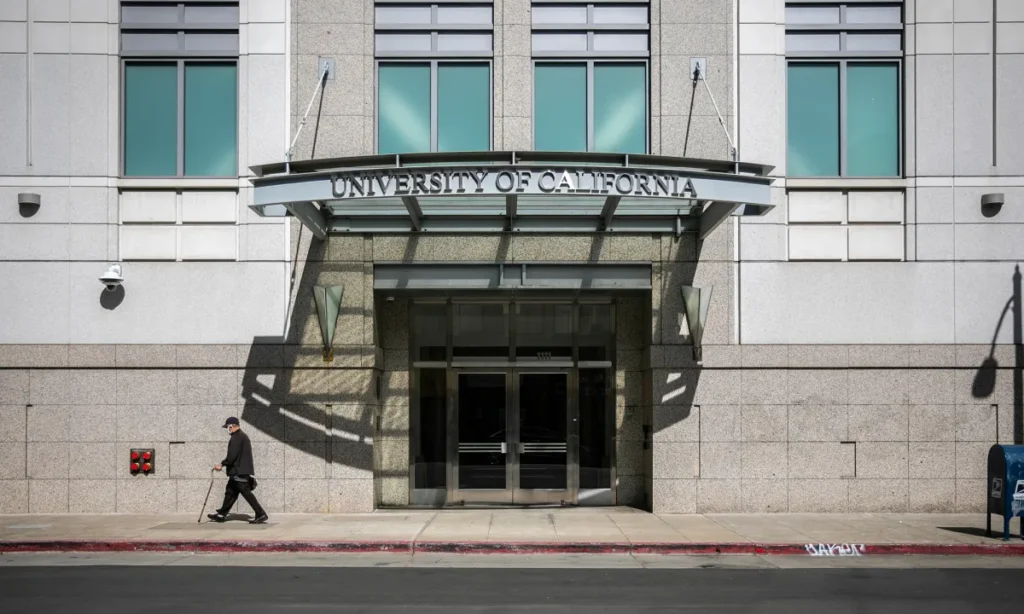Cal Maritime's enrollment drop has prompted a proposal to merge the state's smallest public university with Cal Poly SLO. The board will review the proposal on Tuesday and again in September. Action is expected in November. (Flickr/Cal Maritime)

- CSU board to discuss $35M plan to blend Cal Maritime's 761 students into Cal Poly SLO's 22,000-person student body by 2026.
- Faculty at both schools express uncertainty about proposal's impact on jobs, admissions, degree conferral, and recruitment.
- Reports of sexual misconduct at Cal Maritime overshadow campus improvements in training, prevention, and responsiveness.
Share
|
Getting your Trinity Audio player ready...
|
A steep drop in enrollment has put Cal Maritime, the smallest of the California State University’s 23 campuses, on a path to merge with Cal Poly San Luis Obispo.

Amy DiPierro
EdSource
Under the plan, which will go before the Cal State board of trustees for discussion Tuesday, Cal Maritime’s 761 students would blend into San Luis Obispo’s 22,000-person student body with the goal of saving on overhead and ultimately attracting more students to the maritime academy.
Recruiting out-of-state students and competing for federal dollars are two pieces of the turnaround plan, according to newly released details about the proposal.
But faculty at both institutions said they have received little guidance about how the plan would impact their day-to-day jobs. And CSU officials’ proposal to the board does not address what one investigation into sexual harassment at Cal Maritime called a “history of pervasive male toxicity.”
The CSU board of trustees plans to open discussions on the proposal on Tuesday and raise the subject again in September. A vote on the proposed integration is set for November. If approved, CSU officials estimate bringing the two institutions together will cost $35 million over seven years. The plan would go into effect in July 2025 and affect students in the fall of 2026.
In response to questions seeking more information about admissions, degree conferral and recruitment strategy under the proposal, CSU spokesperson Amy Bentley-Smith said it would “be speculative and premature to respond to questions about details yet to be determined.” Bentley-Smith said privacy concerns limit what the university can say regarding incidents and reports related to Title IX, the federal sex discrimination law. She said Cal Maritime responds “appropriately with measures aimed at holding individuals accountable for their actions and providing equity to affected members of the community. The university has placed a great deal of focus, energy and commitment on creating a stronger culture of safety and inclusion on campus and on cruise.”
(This article originally appeared on EdSource.)
Cal Maritime, which has a campus in Vallejo and operates a training ship, serves a strategically important niche in higher education. Six state maritime academies together educate most of the nation’s merchant marine officers, the civilian workforce that operates commercial shipping vessels and supplies U.S. military ships and bases. Almost 80% of Cal Maritime students are men, according to fall 2022 enrollment data.
Cal Poly San Luis Obispo, located 250 miles south, is known for its architecture, agriculture and engineering programs. The campus has increased enrollment by 13% over the past decade and receives more qualified applicants than it can accommodate.
Related Story: How and Why to Get a State Seal of Biliteracy | Quick Guide
Merging the campuses would bolster both institutions’ academic strengths in areas like engineering, oceanography, logistics and marine science while allowing degree programs that lead to a merchant marine license from the U.S. Coast Guard to continue, according to the CSU proposal. Cal Maritime would also enjoy access to Cal Poly’s marketing and fundraising resources — a leg up to recruit prospective students and right the school’s finances.
If the marriage of the two schools goes forward, the maritime academy would be led by a superintendent who is also part of Cal Poly leadership, according to documents describing the proposal. Maritime academy faculty and staff, similarly, would become Cal Poly employees.

Righting the Ship
Cal Maritime’s finances are so dire that last spring the university projected that it would have only $317,000 in operating reserves at the end of June 2024 — less than it would need to run the university for three days, according to the merger proposal.
Declining enrollment is a major culprit. Student headcount fell 31% between the 2016-17 and 2023-24 school years. Even if Cal Maritime meets future enrollment targets, Cal State officials write, a growing budget deficit “is inevitable.”
The campus has already slashed spending to save money, CSU officials say, but further cuts would threaten the university’s ability to carry out its educational mission. As it is, CSU officials acknowledge that falling enrollment and budget woes may have had “an impact on the quality of essential student support services such as housing, dining, health and counseling.”
The hope is that maritime academy students will benefit from plugging into Cal Poly’s student services.
Other changes would be subtle. The maritime academy would keep its Vallejo campus during the integration, though additional majors with maritime industry ties could be located there in the future.
Kyle Carpenter, who graduated from Cal Maritime in 2014, said he hopes the proposal can save Cal Maritime. But depending on whether and how majors are folded into Cal Poly, he said, he worries that students who are now required to understand the maritime application of their education could lose that important focus.
“We need to maintain a strong maritime presence, so any bit of maritime education is a great thing,” Carpenter said.
The proposal flags possible benefits for Cal Poly students, too. First among them: Cal Poly students would get access to Cal Maritime laboratory space and, crucially, a $360 million training vessel the campus is set to receive in 2026.
Related Story: Challengers, Incumbents File Early in Fresno-Area School Board Races
The chance to take advantage of the Vallejo campus is welcome news to Yiming Luo, a sophomore city and regional planning major at Cal Poly. He said he hopes the proposal would expand course offerings and give Cal Poly students from the Bay Area like him the “possibility of taking classes at Maritime over the summer for credit.”
Faculty React
Faculty at both campuses said they have lots of questions about how the proposal could impact them.
Steven Runyon, an associate professor of chemistry at Cal Maritime and vice president of the campus California Faculty Association chapter, said the proposed integration “came out of nowhere” and has garnered mixed reactions.
“Many faculty are very optimistic,” he said. “If we’re going to be integrated with any other university, Cal Poly San Luis Obispo is probably top of our list in terms of who we would like to be associated with.”
But Runyon said a lack of clear communication from the university’s leaders makes him worry about how the proposal would impact colleagues, especially those who do not work in a tenure track position, such as lecturers and librarians.
Faculty learned of the merger plan when it was announced on June 5. They can comment “both individually and through their represented body” before the board acts, a Cal Maritime spokesperson said.
Jennifer Mott, an assistant professor of mechanical engineering at Cal Poly, said she has heard little about the proposed integration.
“Will we have to teach more students? Will they be teaching more students?” she said. “Will it not affect anything? We just don’t know any information.”
Mott also questions whether her department would remain independent or merge with Cal Maritime’s mechanical engineering department — a process that would impact her department’s gender makeup.
“We made a huge push in mechanical engineering to hire more women faculty,” she said. “I looked at the faculty (at Cal Maritime) and it’s only men, and so I don’t know how that would affect us going forward.”

Cal Maritime is one of six state maritime academies in the country. (Flickr/Cal Maritime)
A Reckoning With Sexual Misconduct
Reports of sexual misconduct in both the maritime industry and the California State University system have put pressure on Cal Maritime to do more to address sexual misconduct on its campus.
In 2021, an outside investigator commissioned by Cal Maritime reported “several instances of inappropriate, discriminatory, vulgar or offensive writings or other imagery, especially toward female cadets” as well as “concerns over anti-LGBTQIA+ behavior and language used frequently aboard cruises and on campus.”
A Los Angeles Times investigation echoed those issues and found that Cal Maritime failed to follow consistent procedures to address reports of sexual misconduct.
The resignation of Joseph I. Castro as CSU chancellor in 2022 over his mishandling of a Title IX sexual harassment case involving an administrator when he was president of Fresno State resulted in a system-wide reckoning. Cal State retained the law firm Cozen O’Connor to assess programs at each of its 23 universities to deal with sexual harassment and assault complaints under the federal Title IX law that prohibits sex-based discrimination. The probe found that the system lacks resources and staffing to adequately respond to and handle sexual harassment or discrimination complaints from students and employees.
At Cal Maritime, a July 2023 report by the firm found “significant improvements to process, responsiveness, training, and prevention programming” over the previous two years. But Cozen O’Connor reported that those improvements were overshadowed by a lack of a permanent Title IX coordinator, distrust of former university leaders and a culture that discouraged reporting misconduct.
Cal Maritime now has a six-person Title IX implementation team, including a director of Title IX, to implement Cozen O’Connor’s recommendations.
In March 2023, Cal State hired Mike Dumont to serve as the maritime academy’s interim president. A 2024 profile of Dumont in the San Francisco Chronicle names several recent reforms at the campus, including improving training on sexual harassment, hiring a full-time victim advocate and updating uniform, naming and housing policies to meet the needs of nonbinary and transgender students.
In a statement, Bentley-Smith said the work of improving campus safety and inclusion “continues and will continue, both at Cal Maritime and throughout the CSU. One of the CSU’s highest priorities is ensuring all students and employees across our 23 universities are protected from discrimination and harassment.”
This month, Gov. Gavin Newsom signed a law requiring CSU to implement the recommendations of a state audit into its handling of sexual misconduct. CSU officials say the system is already in the process of meeting the audit requirements.
But Mott, the Cal Poly professor, said reports of sexual harassment and assault at Cal Maritime give her pause.
“I know it’s an issue across a lot of campuses, not to say that we don’t have issues here,” she said. “But if it is a more toxic culture up there (at Cal Maritime), that is definitely a concern that we don’t bring that here, or that the students aren’t forced to go up there if they don’t feel comfortable going to that environment.”
Funding From Fees, Feds and More
The proposal anticipates a combined institution could raise more philanthropic and federal dollars. It is possible Cal Poly’s fee model — increasing one fee and levying a second on out-of-state undergraduates to pay for more financial aid — could be applied to the maritime academy.
The proposal also argues that Cal Maritime has a great story to tell prospective students and can use San Luis Obispo’s “unquestioned expertise in strategic enrollment management, marketing and brand-building” to tell it.
One draw is graduates’ future earnings. An analysis by the Georgetown University Center on Education and the Workforce found that a Cal Maritime degree had the highest return on investment of any bachelor’s degree from a public university in California as measured by its net present value.
Related Story: Southern California School District Sues Gov. Newsom Over New Gender-Identity ...
Under the proposal, increased outreach would extend to prospective students in Oregon, Washington, Alaska, Hawaii and U.S. Pacific territories.
Michael Fossum, the superintendent of the Texas A&M Maritime Academy, said maritime academy graduates are in high demand. But schools like his don’t always have the marketing budget to pitch prospective students on pursuing the career.
“It’s a massive industry that people don’t know about,” he said. “We don’t have the reach to help educate people on how important the industry is and what great opportunities there are working in this industry.”

‘A Nationally Known Name’
If the integration proposal wins board approval, Cal Maritime’s future might look a little more like Fossum’s institution, Texas A&M Maritime Academy.
The Texas maritime academy is not an independent institution, but is part of Texas A&M at Galveston. In terms of leadership structure, Fossum, the school’s superintendent, is also chief operating officer at Texas A&M University at Galveston and a vice president at Texas A&M University. That structure reduces some overhead on his campus.
“I don’t have to replicate every single vice president and every single function that’s on the main campus,” Fossum said.
The Cal Maritime integration proposal suggests the two campuses could experience similar consolidation in areas such as facilities maintenance, information technology, cybersecurity and administrative services like payroll and accounting.
Fossum said he hopes that if Cal Maritime links up with Cal Poly, it will enjoy some of the same reputational benefits his campus experiences from its close association with Texas A&M.
“Cal Poly has got a nationally known name,” he said. “When you get the power of Cal Poly, just like me having the power of Texas A&M University, that absolutely helps. The association is good.”
About the Author
Amy DiPierro covers higher education and the California State University system.


















